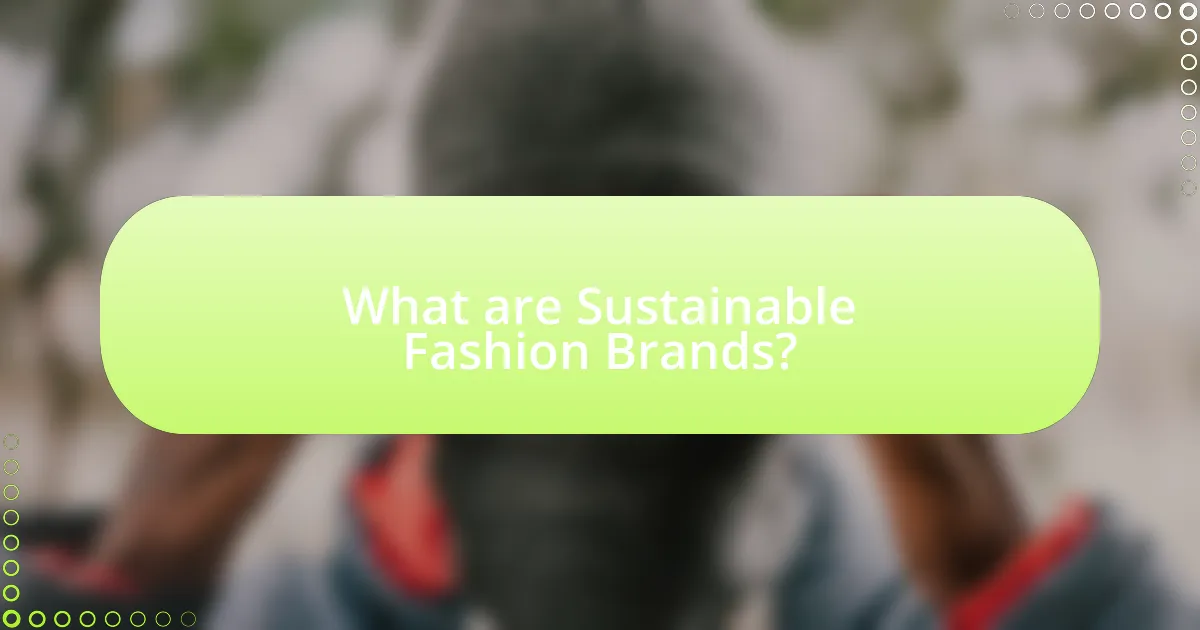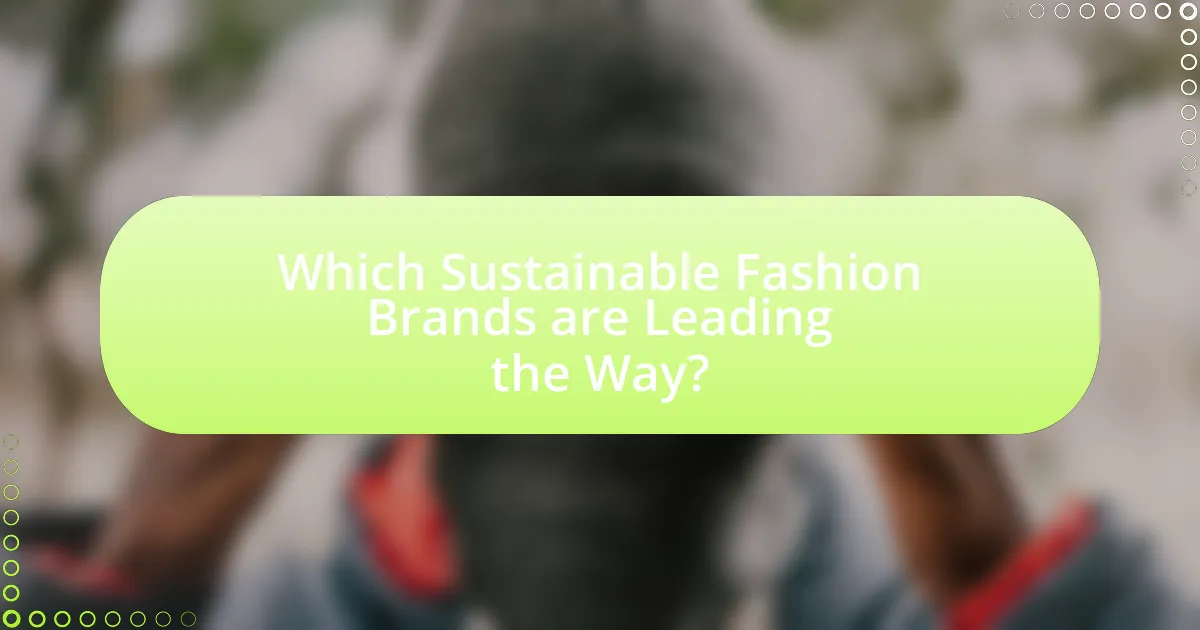Sustainable fashion brands are companies that emphasize environmentally friendly practices and ethical production methods in their clothing and accessory lines. This article explores the characteristics that differentiate sustainable brands from traditional ones, the materials they typically use, and the impact of production processes on sustainability. It highlights the importance of sustainability in the fashion industry, the environmental issues associated with fast fashion, and how consumer behavior influences the demand for eco-conscious products. Additionally, the article profiles leading sustainable brands like Patagonia, Stella McCartney, and Eileen Fisher, discusses the challenges these brands face, and outlines best practices for consumers to support sustainable fashion.

What are Sustainable Fashion Brands?
Sustainable fashion brands are companies that prioritize environmentally friendly practices and ethical production methods in their clothing and accessory lines. These brands focus on reducing waste, using sustainable materials, and ensuring fair labor practices throughout their supply chains. For example, brands like Patagonia and Eileen Fisher utilize recycled materials and promote transparency in their sourcing, demonstrating a commitment to sustainability. The global sustainable fashion market is projected to reach $8.25 billion by 2023, reflecting a growing consumer demand for eco-conscious products.
How do Sustainable Fashion Brands differ from traditional brands?
Sustainable fashion brands differ from traditional brands primarily in their commitment to environmentally friendly practices and ethical production methods. While traditional brands often prioritize profit and rapid production, sustainable brands focus on reducing their ecological footprint by using organic materials, minimizing waste, and ensuring fair labor practices. For instance, a report by the Global Fashion Agenda highlights that sustainable brands typically utilize recycled materials and adopt circular economy principles, which contrasts sharply with the linear model of traditional fashion that emphasizes mass production and consumption.
What materials do Sustainable Fashion Brands typically use?
Sustainable fashion brands typically use organic cotton, Tencel, hemp, recycled polyester, and organic linen. These materials are chosen for their lower environmental impact compared to conventional fabrics. For instance, organic cotton is grown without harmful pesticides, Tencel is made from sustainably sourced wood pulp, and recycled polyester reduces plastic waste by repurposing existing materials. This focus on eco-friendly materials aligns with the principles of sustainability, aiming to minimize harm to the planet while promoting ethical production practices.
How do production processes impact sustainability in fashion?
Production processes significantly impact sustainability in fashion by determining resource usage, waste generation, and environmental footprint. For instance, conventional textile manufacturing often involves high water consumption and chemical pollution, whereas sustainable practices, such as using organic materials and eco-friendly dyes, reduce these negative effects. According to the Ellen MacArthur Foundation, the fashion industry is responsible for 20% of global wastewater and 10% of carbon emissions, highlighting the urgent need for sustainable production methods. By adopting circular production processes, brands can minimize waste and promote recycling, further enhancing sustainability in the fashion sector.
Why is sustainability important in the fashion industry?
Sustainability is important in the fashion industry because it addresses the environmental and social impacts of clothing production. The fashion industry is responsible for approximately 10% of global carbon emissions and is a major contributor to water pollution and waste. By adopting sustainable practices, brands can reduce their ecological footprint, promote ethical labor practices, and foster a circular economy. For instance, using organic materials and recycling processes can significantly lower resource consumption and waste generation, making the industry more environmentally friendly.
What environmental issues are associated with fast fashion?
Fast fashion is associated with several significant environmental issues, including excessive waste, water pollution, and high carbon emissions. The fast fashion industry produces approximately 92 million tons of textile waste annually, much of which ends up in landfills. Additionally, the production processes often involve toxic dyes and chemicals that contaminate water sources, affecting ecosystems and human health. Furthermore, the industry is responsible for about 10% of global carbon emissions, contributing to climate change. These factors highlight the detrimental impact of fast fashion on the environment.
How does consumer behavior influence sustainable fashion?
Consumer behavior significantly influences sustainable fashion by driving demand for eco-friendly products and practices. As consumers increasingly prioritize sustainability, brands are compelled to adopt environmentally responsible practices, such as using organic materials and ethical labor. A study by McKinsey & Company found that 67% of consumers consider the use of sustainable materials important when making fashion purchases, highlighting the direct correlation between consumer preferences and brand strategies. This shift in consumer behavior not only encourages brands to innovate but also fosters a competitive market focused on sustainability, ultimately shaping the future of the fashion industry.

Which Sustainable Fashion Brands are Leading the Way?
Patagonia, Stella McCartney, and Eileen Fisher are leading sustainable fashion brands. Patagonia is renowned for its commitment to environmental activism and uses recycled materials in its products, with over 68% of its materials sourced sustainably. Stella McCartney is a pioneer in luxury sustainable fashion, utilizing innovative materials like vegan leather and promoting ethical production practices. Eileen Fisher focuses on organic and recycled fibers, with a goal of achieving 100% sustainability by 2025, and has implemented a take-back program to recycle old garments. These brands exemplify leadership in the sustainable fashion movement through their innovative practices and commitment to eco-consciousness.
What are some notable examples of pioneering Sustainable Fashion Brands?
Notable examples of pioneering sustainable fashion brands include Patagonia, Stella McCartney, and Eileen Fisher. Patagonia is recognized for its commitment to environmental activism and using recycled materials in its products. Stella McCartney has been a leader in advocating for cruelty-free fashion and sustainable practices since her brand’s inception in 2001. Eileen Fisher focuses on ethical sourcing and has implemented a take-back program to recycle old garments, demonstrating a commitment to circular fashion. These brands exemplify innovation and responsibility in the fashion industry, setting benchmarks for sustainability.
How do these brands implement eco-friendly practices?
These brands implement eco-friendly practices by utilizing sustainable materials, reducing waste, and promoting ethical production methods. For instance, many sustainable fashion brands source organic cotton, recycled polyester, and other eco-friendly fabrics to minimize environmental impact. Additionally, they often adopt zero-waste design techniques, which aim to eliminate textile waste during the production process. Brands also emphasize fair labor practices, ensuring that workers are treated ethically and compensated fairly, which aligns with their commitment to sustainability. This multifaceted approach not only addresses environmental concerns but also supports social responsibility within the fashion industry.
What unique features set these brands apart in the market?
Sustainable fashion brands are distinguished in the market by their commitment to eco-friendly materials, ethical production practices, and transparency in supply chains. For instance, brands like Patagonia utilize recycled materials and promote fair labor practices, which resonate with environmentally conscious consumers. Additionally, companies such as Reformation focus on sustainable sourcing and carbon neutrality, appealing to a demographic that prioritizes environmental impact. These unique features not only enhance brand loyalty but also position these companies as leaders in the growing eco-conscious fashion sector.
How are these brands influencing the fashion industry?
Sustainable fashion brands are influencing the fashion industry by promoting eco-friendly practices and materials, which challenge traditional manufacturing methods. These brands, such as Patagonia and Stella McCartney, advocate for transparency in supply chains and emphasize the importance of ethical labor practices. For instance, Patagonia’s commitment to using recycled materials has set a benchmark, with over 69% of its products made from recycled fabrics as of 2021. This shift encourages other brands to adopt similar sustainable practices, thereby reshaping consumer expectations and industry standards. Additionally, the rise of circular fashion initiatives, where brands focus on recycling and upcycling, further drives innovation and sustainability in the industry.
What trends are emerging from the success of these brands?
Emerging trends from the success of sustainable fashion brands include increased consumer demand for transparency, a shift towards circular fashion practices, and the integration of technology in sustainable production. Transparency is evident as brands disclose their supply chains and sourcing practices, appealing to environmentally conscious consumers. Circular fashion practices, such as recycling and upcycling, are gaining traction as brands focus on reducing waste and extending the lifecycle of products. Additionally, technology is being leveraged for sustainable innovations, such as using eco-friendly materials and implementing efficient production processes, which enhances brand credibility and consumer trust. These trends reflect a broader movement towards sustainability in the fashion industry, driven by consumer awareness and environmental concerns.
How are traditional brands responding to the rise of sustainable fashion?
Traditional brands are increasingly adopting sustainable practices in response to the rise of sustainable fashion. Many established companies are integrating eco-friendly materials, such as organic cotton and recycled polyester, into their product lines to reduce environmental impact. For instance, brands like H&M and Nike have launched initiatives aimed at increasing the use of sustainable materials, with H&M’s Conscious Collection featuring garments made from organic and recycled fabrics. Additionally, traditional brands are implementing transparent supply chains and committing to ethical labor practices, as seen in Levi’s Water Sustainable fashion brands face significant challenges, including high production costs, limited consumer awareness, and supply chain complexities. High production costs arise from the use of eco-friendly materials and ethical labor practices, which can lead to higher retail prices compared to conventional fashion. Limited consumer awareness affects demand, as many consumers are still unfamiliar with the benefits of sustainable fashion, leading to a lack of market penetration. Additionally, supply chain complexities involve sourcing sustainable materials, ensuring ethical labor practices, and managing logistics, which can complicate operations and increase costs. These challenges hinder the growth and scalability of sustainable fashion brands in a competitive market. The main obstacles to achieving sustainability in fashion include high production costs, lack of consumer awareness, and insufficient regulatory frameworks. High production costs arise from the need for sustainable materials and ethical labor practices, which can significantly increase the price of garments. Lack of consumer awareness limits demand for sustainable products, as many consumers prioritize price and convenience over environmental impact. Insufficient regulatory frameworks fail to enforce sustainable practices across the industry, allowing unsustainable practices to persist. According to a 2021 report by McKinsey & Company, only 1% of fashion companies are on track to meet sustainability targets, highlighting the systemic challenges within the industry. Supply chain issues negatively impact sustainable practices by disrupting the availability of eco-friendly materials and increasing reliance on less sustainable alternatives. For instance, when supply chains face delays or shortages, brands may resort to using synthetic materials or lower-quality resources that do not align with their sustainability goals. Additionally, inefficiencies in logistics can lead to increased carbon emissions, undermining efforts to reduce environmental footprints. A study by the World Economic Forum highlights that supply chain disruptions can lead to a 20% increase in carbon emissions for companies that do not prioritize sustainability in their sourcing and logistics strategies. Consumer education plays a crucial role in overcoming challenges faced by sustainable fashion brands by empowering consumers with knowledge about the environmental and social impacts of their purchasing decisions. Educated consumers are more likely to support brands that prioritize ethical practices, thereby driving demand for sustainable products. For instance, a study by the Global Fashion Agenda indicates that informed consumers can significantly influence market trends, leading to a 30% increase in sales for brands that adopt sustainable practices. This shift not only encourages brands to adopt eco-friendly methods but also fosters a culture of sustainability within the fashion industry. Consumers can support sustainable fashion brands by choosing to purchase from companies that prioritize ethical production practices and environmentally friendly materials. By selecting brands that are transparent about their supply chains and use sustainable materials, consumers contribute to a market demand for eco-conscious practices. Research indicates that the global sustainable fashion market is projected to reach $8.25 billion by 2023, highlighting a growing consumer preference for sustainable options. Additionally, consumers can engage in practices such as buying second-hand clothing, participating in clothing swaps, and advocating for sustainable policies, further reinforcing the importance of sustainability in the fashion industry. The best practices for choosing sustainable fashion options include prioritizing brands that use eco-friendly materials, ensuring ethical labor practices, and supporting circular fashion initiatives. Eco-friendly materials, such as organic cotton, Tencel, and recycled fabrics, reduce environmental impact by minimizing resource consumption and pollution. Ethical labor practices ensure fair wages and safe working conditions, which are crucial for social sustainability. Supporting circular fashion initiatives, like clothing rental, resale, and recycling programs, helps reduce waste and promotes a more sustainable lifecycle for garments. According to the Global Fashion Agenda’s 2021 report, sustainable practices can significantly reduce the fashion industry’s carbon footprint, highlighting the importance of these best practices. Consumers can advocate for sustainability in the fashion industry by making informed purchasing decisions that prioritize eco-friendly brands and practices. By choosing to buy from companies that utilize sustainable materials, implement ethical labor practices, and promote transparency in their supply chains, consumers can directly influence market demand for sustainable fashion. Research indicates that 66% of global consumers are willing to pay more for sustainable brands, demonstrating a significant shift towards eco-conscious purchasing behavior. Additionally, consumers can engage in activism by supporting policies that promote sustainability, participating in awareness campaigns, and sharing information about sustainable practices on social media platforms.
What Challenges do Sustainable Fashion Brands Face?
What are the main obstacles to achieving sustainability in fashion?
How do supply chain issues affect sustainable practices?
What role does consumer education play in overcoming these challenges?
How can consumers support Sustainable Fashion Brands?
What are the best practices for choosing sustainable fashion options?
How can consumers advocate for sustainability in the fashion industry?
